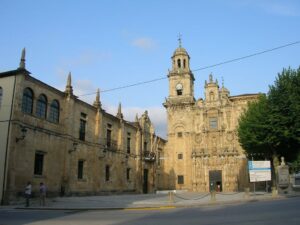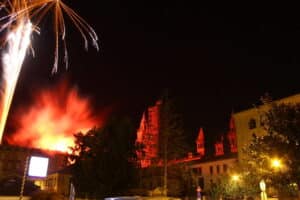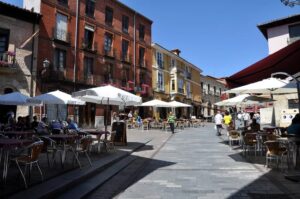 Have you ever heard of the end of the world? Well, this time, we are taking you to a place that has been called just that. Finisterre, known as the point where the land ends and the mystery of the ocean begins, has sparked the curiosity of countless people throughout history.
Have you ever heard of the end of the world? Well, this time, we are taking you to a place that has been called just that. Finisterre, known as the point where the land ends and the mystery of the ocean begins, has sparked the curiosity of countless people throughout history.
Adventurers, pilgrims, and dreamers have journeyed here in search of answers, breathtaking landscapes, and unforgettable experiences. Curious to know what it feels like to be in a place that seems like the end of everything? We invite you to keep reading.
Índice de contenidos
The Fascinating History of Finisterre
Finisterre, or Fisterra in Galician, has long been considered the “End of the World“. This name comes from the Latin finis terrae, meaning “end of the land”. In Roman times, it was believed to be the westernmost point of Europe, where the sun set into the ocean.
Over the centuries, the region has been a meeting point for various cultures, including the Celts and Christians, each leaving their mark on this magical place.
The legends surrounding Finisterre are as rich as its history. It’s said that ancient pagans performed rituals here in honour of the sun, believing there was an altar dedicated to Ara Solis. They would make sacrifices to ensure good harvests and protection.
With the arrival of Christianity, these traditions blended with new beliefs, turning Finisterre into a pilgrimage destination. Many walkers, after reaching Santiago de Compostela, continue their journey to this symbolic cape, seeking purification and closure to their path.
Today, some modern rituals are still observed by pilgrims who reach Finisterre. Although not official rites, many perform them as a personal way of concluding their pilgrimage.
One of the most well-known is the naked swim on nearby beaches, a symbolic act of purification and renewal. Another common ritual is to wash or burn the clothes and boots worn during the Camino, symbolising the end of one stage and the beginning of a new one.
The Camino de Santiago to Finisterre
The Camino de Santiago doesn’t end at the cathedral in Santiago de Compostela. The journey continues for approximately 90 kilometres, offering stunning views and a deep connection to both nature and history. It is typically divided into four stages:
- Santiago to Negreira.
- Negreira to Olveiroa.
- Olveiroa to Cee.
- Cee to Finisterre.
There are several travel companies specialising in the Camino de Santiago that help make the experience easier for pilgrims. They offer services such as luggage transport, accommodation, guides, and personalised routes to make the journey more comfortable and organised.
However, there are different ways to complete the route:
- You can choose to walk the Camino to Finisterre and enjoy the tranquillity of the paths and the beauty of the landscape.
- Alternatively, you could also take the English Way from Ferrol, which offers a different but equally enriching experience.
- Another option is to walk the Camino Primitivo, one of the oldest and most iconic routes of the Camino de Santiago. This route, full of mountainous landscapes and historic trails, offers a quieter and more authentic experience for pilgrims.
- Consider walking the English Way for a great combination of exercise and self-reflection, discovering something new with every step.
- Dare to walk the route from O Cebreiro to Santiago, which combines natural beauty with a rich history.
Upon reaching Finisterre, pilgrims receive the Fisterrana, a certificate that acknowledges their journey. This recognition symbolises the spiritual connection and dedication of those who have walked this path to the end of the world.
Do You Need to Obtain the Compostela Before Receiving the Fisterrana?
No, you don’t need to have obtained the Compostela to receive the Fisterrana. The Fisterrana is a certificate awarded to pilgrims who complete the Camino to Finisterre, regardless of whether they have previously received the Compostela in Santiago de Compostela. It is an independent recognition.
Main Tourist Attractions in Finisterre
Here are the main tourist attractions in this treasured place.
Cape Finisterre
At Cape Finisterre, there is an iconic lighthouse offering spectacular views of the Atlantic Ocean. Dating back to the 18th century, it stands atop impressive cliffs, creating a breathtaking landscape. From here, visitors can watch the sun set into the sea, a sight that has inspired many over the centuries.
Langosteira Beach
This pristine beach stretches out for almost three kilometres. With its crystal-clear waters and fine white sand, it’s a perfect spot to unwind after a long walk. Pilgrims often collect shells here as souvenirs of their journey.
The Hermitage of San Guillermo
Dating back to the 14th century, this hermitage has long been a place of worship and reflection. Nestled high up on the hill, it offers visitors a quiet retreat with magnificent views.
The Fishermen’s Quarter
The charm of the local fishing culture comes alive here. Walk through the streets of the fishermen’s quarter and discover a different side of Finisterre, full of tradition and local character.









